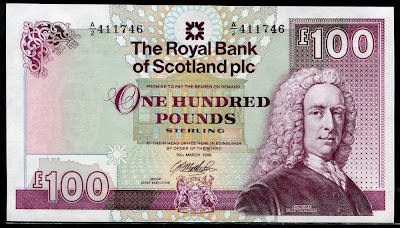Negative interest rates and what it means
| December 18th, 2016 at 6:57:59 AM permalink | |
| Pacomartin Member since: Oct 24, 2012 Threads: 1068 Posts: 12569 | I think that Cesspit's comments are interesting. In 1981 the 50 pound note was only worth about US$100 (today it is roughly $63) and the 20 pound note was worth about $40. Circulation of 50 pound note in millions of pieces Mar 20, 1981 introduced Feb 28, 1982 5.48 Feb 28, 1983 12.66 Feb 29, 1984 18.18 Feb 28, 1985 21.78 Feb 28, 1986 24.66 Feb 28, 1987 29.50 Feb 29, 1988 35.10 Feb 28, 1989 41.08 Feb 28, 1990 45.84 Feb 28, 1991 47.50 Feb 29, 1992 50.30 Feb 28, 1993 54.64 Feb 28, 1994 57.68 Apr 20, 1994 Houbloun 50 pound banknote introduced Sep 20, 1996 Wren banknote demonetized
So despite the relatively small number of banknotes (for a population of roughly 60 million), Cesspit remembers them as common in an industry that prefers cash. The idea of cash is very powerful. If the federal governments pull out of cash, then private industry or banks will step back in and provide the equivalent.  |
| November 26th, 2017 at 2:40:21 PM permalink | |
| Pacomartin Member since: Oct 24, 2012 Threads: 1068 Posts: 12569 | It looks like negative interest rates once adopted are difficult to shake. Ten years ago a negative interest rate by a central bank was only a concept. In sweden the repo-rate varied from +1.50% to 4.75% from 2000 to 2011 Traditional economic theory holds that people will convert bank accounts into cash without the inducement of earning interest. The Swedish Riksbank deposit rate is the rate of interest banks receive when they deposit funds in their accounts at the Riksbank overnight and is normally 0.75 percentage points lower than the repo rate. The deposit rate dropped to zero percent on December 18, 2013 only two weeks before the 1000 - kronor Vasa banknotes without foil (~$120) became invalid.Seven months later the deposit rate went from zero to negative and is forecast to remain zero or below at least seven years. Forecast for the repo rate by Swedish Central Bank 2017 Q 3 -0.50% 2017 Q 4 -0.50% 2018 Q 1 -0.50% 2018 Q 4 -0.27% 2019 Q 4 +0.24% 2020 Q 4 +0.75% -> deposit rate is zero. The suspicion became widespread that the huge reduction in circulation levels of banknotes (50% from 2007 to 2016) is related to monetary policy. Under the best of circumstances banks consider cash a money losing proposition, but with negative interest rates it becomes a severe liability. |
| November 26th, 2017 at 6:48:29 PM permalink | |
| petroglyph Member since: Aug 3, 2014 Threads: 25 Posts: 6227 | Banks may not like the inconvenience of cash, but I would think they would hate Bitcoin cutting them entirely out of the loop? Banks did fine under the cash system, with fees on everything money. The last official act of any government is to loot the treasury. GW |
| September 27th, 2019 at 7:17:25 AM permalink | |
| Pacomartin Member since: Oct 24, 2012 Threads: 1068 Posts: 12569 | The moneyfactory.gov (website for Bureau of Engraving and Printing ) stopped poscting monthly production reports in January. That may seem like a minor quibble, but the last time they stopped printing monthly production reports was about a decade ago.
BTW I am guessing that box has 30 stacks of 2*1000 notes per bundle. So I am guessing upwards of $60 million. Steven T. Mnuchin who has been Secretary since February 13, 2017 has his signature on the $1, $10, and $20. Jacob J. Lew, Secretary of Treasury under President Obama from February 28, 2013 until January 20, 2017 still has the signature on the new $2, $5, $50 and $100 banknotes. While it often takes some time to get the new Secretary's signature on a new series of notes, a delay of over 2.5 years doesn't normally happen unless there is a problem. Since the monthly production reports have stopped being posted since January, the plausible explanation is that the production process has broken down again. It is unlikely that problems are with the smaller denominations because the banknotes are far less complicated. It's interesting that President Trump has been pushing zero or negative interest rates with his tweets. If he creates a panic situation and people begin hoarding $100 bills just as there is a production issue, then we might have a chaotic reaction. The 1000 Swiss Franc banknote worth ~$1000 is far more complex than the $100 banknote (with 13 anti-countereiting devices), but it costs 10X as much to produce, and there is no need to print billions of them. |
| September 28th, 2019 at 8:08:17 PM permalink | |
| petroglyph Member since: Aug 3, 2014 Threads: 25 Posts: 6227 | Why are banks borrowing up to one hundred billion per day? https://wallstreetonparade.com/2019/09/the-fed-is-offering-100-billion-a-day-in-emergency-loans-to-unnamed-banks-and-congress-is-not-curious-enough-to-hold-a-hearing/ The last official act of any government is to loot the treasury. GW |

